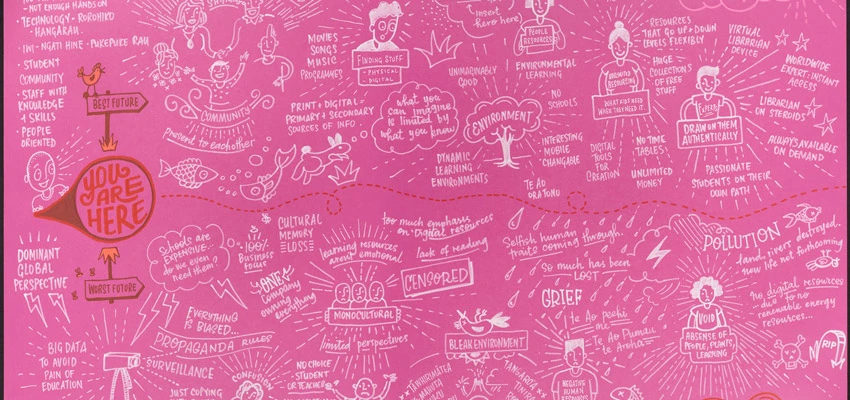
Increasingly Digital project
Increasingly Digital was a multi-agency project that explored the access and use of Aotearoa New Zealand teaching and learning resources.
Organisations involved
The organisations involved were National Library (lead), Ministry of Education, Ministry for Culture and Heritage, NZRise, NZTech, and New Zealand Council for Educational Research (NZCER).
Purpose of the project
The purpose of the Increasingly Digital project was to explore how students and teachers discover, access, use, create, and share resources to support learning in current and future learning environments.
The project had a particular focus on Aotearoa New Zealand heritage knowledge and content specifically related to He Tohu and Tuia — Encounters 250.
What did the project involve?
The project involved:
a national survey of schools
case studies with a small sample of schools and kura
resource research and development
exploring future learning environments.
National survey of schools
The purpose of the survey was to provide a national sample snapshot of how students and teachers discover, access, use, create, and share resources in their specific schools and communities (or learning environments).
NZCER was contracted to develop, deliver, and analyse the results from the project’s survey. The survey was informed by case study insights and developed by NZCER and National Library with input from project partners. It was delivered to a representative sample of 600 English-medium schools and 100 Māori-medium kura in mid-June 2018.
Report: National survey of schools for the Increasingly Digital project (pdf, 3.8MB)
School and kura case studies
The case studies and the survey were designed to complement each other. The survey provided a broad and general picture of schools’ resource use. The case studies provided a series of smaller, deeper narratives.
NZCER was contracted to undertake the case studies. The studies involved NZCER researchers and National Library Capability Facilitators working with 7 schools and 2 kura kaupapa to explore how they discover, access, use, create, and share resources. The researchers and facilitators visited schools and held workshops in Wellington and Auckland.
Report: School and kura case studies for the Increasingly Digital project (pdf, 2MB)
Resource research and development
Resource research
The project established a data analysis and research team to investigate data and resources created and owned by project partners. The objectives of this work were as follows:
Uncover themes, trends, and patterns about the ways in which teachers and students are discovering and accessing learning resources within partner agency collections.
Create a systematic, integrated map of the current provision of culture and heritage learning resources.
Communicate the stories of how teachers and students discover and access resources based on analysis of the data.
Resource development
The project also developed resources in both te reo Māori and English to address priorities identified by case study schools and project partners.
Te reo Māori resources — interactive digital biography stories
The project created an interactive storybook app that tells the story of Turikatuku, a prominent tupuna from Whangaroa. It documents Turikatuku’s whakapapa, the history of her people, and important events that impacted them in the early 1800s.
This resource provides te reo Māori curriculum content for Māori medium students and teachers involved in the case studies and for the partner agencies in the project.
Te Kura Kaupapa Māori o Whangaroa researched and wrote the narrative for the app in partnership with the National Library of New Zealand. Kiwa Digital developed the software and illustrations.
Storybook app: Turikatuku — Te wahine taki wairua
English resources — curiosity cards
The project created a set of 15 completed curiosity cards, each containing an Aotearoa New Zealand heritage item and a series of ‘fertile’ questions. Fertile questions are an established type of inquiry question, designed to act as a catalyst for deep thinking and exploration.
The cards were tested at multiple levels and respond to identified resource gaps, including resources for younger people (including printed material).
Selected cards include a question written in te reo Māori. The te reo Māori questions were formulated in te reo rather than translated.
The first-released curiosity cards depict heritage items relevant to 2 Aotearoa New Zealand initiatives:
the He Tohu exhibition, with a specific focus on Women’s Suffrage, aligning with Suffrage 125 celebrations
the Tuia — Encounters 250 programme.
Each card has a link to a set of curated resources on the DigitalNZ website that gives more information about the heritage item, including its context and background.
Future learning environments
The project explored learning resource access and use in both current and future learning environments. The national survey and case study work with schools provided the context for investigating current learning environments. Future-thinking workshops were run with both case study schools and project partners to explore future learning environments
In June 2018, NZCER facilitated these workshops. At the workshops, participants discussed theories for futures thinking. They also took part in an exercise on thinking about the future.
Live illustrations were created at the workshops to capture the discussions and visions that project partners and schools had for the future of learning resources:

A live illustration of the case study schools' futures thinking at a project workshop in June 2018
View full-sized image (jpg,744KB)

A live illustration of the project partners' futures thinking at a project workshop in June 2018
Feature image at top of page: Increasingly Digital project illustration developed at a project workshop in June 2018 by the League of Live Illustrators